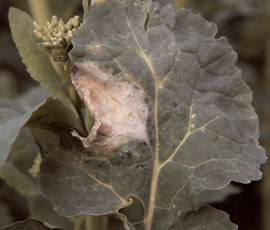Light leaf spot alert for backward oilseed rape

Oilseed rape growers should be on high alert for signs of light leaf spot this spring as the disease costs farmers over £100m each year in lost yield.
The number one disease threat to oilseed rape crops can cut yields by up to 1t/ha, which could put a severe dent into profit margins with rapeseed trading at almost £400/t.
Peter Gladders, plant pathologist at crop consultants ADAS, advises growers to get out into fields and look for the disease even in late-drilled, backward crops.
“If you see it in the crop you should not hang about, especially with crop values at current levels,” says Dr Gladders.
With such wet weather last autumn, many growers will not have had a chance to apply a light leaf spot fungicide then, so treatment is key if the disease is present in the early spring.
The fear is that with a lot of small later-sown oilseed rape plants this season, light leaf spot could be later to develop than usual so growers need to be on their toes, he says.
With varietal resistance generally poor and oilseed rape grown more frequently in tighter crop rotations, there is a real risk of the disease taking a hold this spring.
Dr Gladders says if 15% of plants are infected at the early stem extension stage then yields can be hit by 5%, so early control is essential to prevent infestation becoming even worse.
On backward crops there is currently little light leaf spot around, but if the disease starts to be seen then Dr Gladders’ first treatment choice would be the triazole, prothioconazole (Proline).
“This gives good action against the disease, but be prepared to come back in four weeks’ time with another spray,” says Dr Gladders.
The disease is usually more prevalent in northern England and Scotland where growers often spray twice in the spring, and sometimes three times, including an autumn application.
Mark Hemmant, agronomist at adviser Agrovista, agrees with Dr Gladders that growers should check oilseed rape crops and treat at the first sign of disease.
Some forward crops are already showing the classic leaf symptoms of the disease in East Anglia, he says.
“Treatment can’t wait until stem extension as you lose a lot of yield potential,” he adds.
Light leaf spot treatments are preventative rather than curative. Therefore, he highlights the need to catch it early with the fungicide prothioconazole.
The threshold for spraying is if 15% of plants are infected, but Mr Hemmant urges growers to treat at the first sign of this yield-sapping disease.
The chance to skip an early T0 wheat fungicide spray
Winter wheat growers may be able to save an early fungicide spray this season with disease levels generally low in late-drilled backward crops.
With less disease around it could make less economic sense to stick with an early spring T0 fungicide spray with low levels of septoria and yellow rust seen in crops.
“This spring we are facing variable disease risk, and for later sown crops it may be OK to skip on the T0 spray,” Dr Gladders says.
Disease levels are still damped down after a prolonged spell of wet and cold weather so Dr Gladders is not as keen on a T0 March spray and growers should focus instead on later T1 and T2 sprays.
In these cases, Dr Gladders advises growers to focus on the T1 April spray timing using a triazole plus chlorothalonil, a protectant multi-site product to which no resistance has been detected.
He would only resort to adding a new SDHI fungicide active at the T1 timing if septoria infection is high.
His approach at the flag leaf T2 May spray timing would be a combination of a triazole, SDHI and chlorothalonil.
After last season’s heavy fusarium disease levels, he urges attention to a T3 ear spray in June as there will be disease carry-over from stubble and seed.
“There will be a bigger fusarium load going into this season. Last year, growers went in too late and at too low a dose.
Fusarium developed when a dry May was followed by a wet June at early flowering, so he suggests growers should be prepared to use a fungicide soon after the wheat ears emerge if the weather suggests crops are at high risk.

